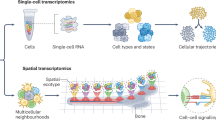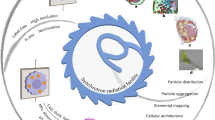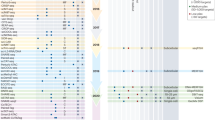Abstract
A fundamental goal in modern biology and precision medicine is to acquire rich, multi-omics-style information from cells, including transcriptomic, proteomic, metabolic and electrophysiological data, in real time and at single-cell resolution. However, current techniques often rely on destructive endpoint assays that require cell lysis, losing spatial, temporal and dynamic context. Nanoscale sensors offer a transformative solution by enabling minimally invasive, continuous monitoring of intracellular activities. Here we propose a spatial classification of intracellular sensing technologies—near cell, on cell and in cell—and use this framework to evaluate the sensing modalities on the basis of their invasiveness, signal fidelity and resolution. We highlight emerging sensor platforms that are capable of detecting ions, metabolites, electrical signals and mechanical changes, as well as artificial intelligence-driven strategies for decoding complex cellular data streams. We further consider the integration of these nanosensors into three-dimensional, physiologically relevant models such as organoids to create ‘smart organoids’ that report on their internal state autonomously and in real time. Finally, we discuss the major challenges in achieving intelligent intracellular sensing, including issues of sensor miniaturization, biocompatibility, multiplexing and three-dimensional integration. Together, these advances set the stage for a new era of dynamic, high-resolution cell profiling that can accelerate drug discovery, disease modelling and personalized medicine.
This is a preview of subscription content, access via your institution
Access options
Access Nature and 54 other Nature Portfolio journals
Get Nature+, our best-value online-access subscription
$32.99 / 30 days
cancel any time
Subscribe to this journal
Receive 12 print issues and online access
$259.00 per year
only $21.58 per issue
Buy this article
- Purchase on SpringerLink
- Instant access to full article PDF
Prices may be subject to local taxes which are calculated during checkout





Similar content being viewed by others
References
Liu, Z. & Zhang, Z. Mapping cell types across human tissues. Science 376, 695–696 (2022).
Yamanaka, S. Pluripotent stem cell-based cell therapy—promise and challenges. Cell Stem Cell 27, 523–531 (2020).
Baysoy, A., Bai, Z., Satija, R. & Fan, R. The technological landscape and applications of single-cell multi-omics. Nat. Rev. Mol. Cell Biol. 24, 695–713 (2023).
Qiu, S. et al. Small molecule metabolites: discovery of biomarkers and therapeutic targets. Signal Transduct. Target. Ther. 8, 132 (2023).
Rad, M. S., Cohen, L. B., Braubach, O. & Baker, B. J. Monitoring voltage fluctuations of intracellular membranes. Sci. Rep. 8, 6911 (2018).
Zhou, C., Zhao, W.-x., You, F.-t., Geng, Z.-x. & Peng, H.-s. Highly stable and luminescent oxygen nanosensor based on ruthenium-containing metallopolymer for real-time imaging of intracellular oxygenation. ACS Sens. 4, 984–991 (2019).
He, C., Lu, K. & Lin, W. Nanoscale metal–organic frameworks for real-time intracellular pH sensing in live cells. J. Am. Chem. Soc. 136, 12253–12256 (2014).
Zhang, X., Ogorevc, B. & Wang, J. Solid-state pH nanoelectrode based on polyaniline thin film electrodeposited onto ion-beam etched carbon fiber. Anal. Chim. Acta 452, 1–10 (2002).
Soldà, A. et al. Glucose and lactate miniaturized biosensors for SECM-based high-spatial resolution analysis: a comparative study. ACS Sens. 2, 1310–1318 (2017). This study develops miniaturized enzymatic glucose and lactate biosensors using Pt ultramicroelectrodes and enzyme immobilization to enhance the sensitivity and spatial resolution for monitoring metabolic activity at the single-cell level with SECM.
Yuan, X. et al. Versatile live-cell activity analysis platform for characterization of neuronal dynamics at single-cell and network level. Nat. Commun. 11, 4854 (2020). This study presents a dual-mode high-density microelectrode array platform that enables long-term, label-free electrophysiological imaging of neuronal cultures at subcellular, single-cell, and network levels, integrating full-frame (19,584 electrodes) and high-SNR (246 channels) recording modes to support high-throughput analysis of neuronal dynamics.
Jung, H. S. et al. CMOS electrochemical pH localizer-imager. Sci. Adv. 8, eabm6815 (2022).
Cools, J. et al. 3D microstructured carbon nanotube electrodes for trapping and recording electrogenic cells. Adv. Funct. Mater. 27, 1701083 (2017).
Zhou, X.-L., Yang, Y., Wang, S. & Liu, X.-W. Surface plasmon resonance microscopy: from single-molecule sensing to single-cell imaging. Angew. Chem. 132, 1792–1801 (2020).
Tanaka, H. et al. Potassium ion dynamics imaging through supported lipid bilayers with surface plasmon resonance microscopy. ACS Photonics 9, 3412–3420 (2022).
Shinohara, H., Sakai, Y. & Mir, T. A. Real-time monitoring of intracellular signal transduction in PC12 cells by two-dimensional surface plasmon resonance imager. Anal. Biochem. 441, 185–189 (2013).
Nascimento, R. A. S. et al. Single cell “glucose nanosensor” verifies elevated glucose levels in individual cancer cells. Nano Lett. 16, 1194–1200 (2016).
Li, X., Dunevall, J. & Ewing, A. G. Quantitative chemical measurements of vesicular transmitters with electrochemical cytometry. Acc. Chem. Res. 49, 2347–2354 (2016).
Hu, K., Vo, K. L. L., Hatamie, A. & Ewing, A. G. Quantifying intracellular single vesicular catecholamine concentration with open carbon nanopipettes to unveil the effect of L-DOPA on vesicular structure. Angew. Chem. 134, e202113406 (2022).
Xie, C., Lin, Z., Hanson, L., Cui, Y. & Cui, B. Intracellular recording of action potentials by nanopillar electroporation. Nat. Nanotechnol. 7, 185–190 (2012). This study demonstrates the use of vertically aligned nanopillar electrodes to achieve long-term, high-fidelity intracellular and extracellular recordings of cardiomyocyte action potentials by forming tight membrane–electrode junctions and enabling reversible, localized electroporation to significantly reduce cell–electrode impedance, enabling the sensitive pharmacological analysis of ion channel activity.
Jahed, Z. et al. Nanocrown electrodes for parallel and robust intracellular recording of cardiomyocytes. Nat. Commun. 13, 2253 (2022). This study develops semi-hollow nanocrown electrodes for intracellular action potential recordings, enablingparallel and long-term recording in a minimally invasive manner.
Abbott, J. et al. A nanoelectrode array for obtaining intracellular recordings from thousands of connected neurons. Nat. Biomed. Eng. 4, 232–241 (2019). This study presents a CMOS-based, massively parallel intracellular recording system integrating 4,096 vertical nanoelectrode sites, enabling the high-resolution measurement of chemical synapse characteristics and large-scale mapping of synaptic connectivity across neuronal networks.
Liu, R. et al. Ultra-sharp nanowire arrays natively permeate, record, and stimulate intracellular activity in neuronal and cardiac networks. Adv. Funct. Mater. 32, 2108378 (2022).
Spira, M. E., Shmoel, N., Huang, S.-H. M. & Erez, H. Multisite attenuated intracellular recordings by extracellular multielectrode arrays, a perspective. Front. Neurosci. 12, 212 (2018).
Desbiolles, B. X. E., de Coulon, E., Bertsch, A., Rohr, S. & Renaud, P. Intracellular recording of cardiomyocyte action potentials with nanopatterned volcano-shaped microelectrode arrays. Nano Lett. 19, 6173–6181 (2019).
Abbott, J. et al. CMOS nanoelectrode array for all-electrical intracellular electrophysiological imaging. Nat. Nanotechnol. 12, 460–466 (2017). This study introduces a scalable 3D field-effect transistor array platform for the accurate, minimally invasive recording of transmembrane potentials, enabling high-resolution measurements of intracellular signal conduction in cardiomyocytes and cardiac tissue constructs.
Gu, Y. et al. Three-dimensional transistor arrays for intra- and inter-cellular recording. Nat. Nanotechnol. 17, 292–300 (2022).
Hanif, S. et al. Organic cyanide decorated SERS active nanopipettes for quantitative detection of hemeproteins and Fe3+ in single cells. Anal. Chem. 89, 2522–2530 (2017).
Lussier, F. et al. Dynamic-SERS optophysiology: a nanosensor for monitoring cell secretion events. Nano Lett. 16, 3866–3871 (2016).
Yan, R. et al. Nanowire-based single-cell endoscopy. Nat. Nanotechnol. 7, 191–196 (2012).
Rotenberg, M. Y. et al. Silicon nanowires for intracellular optical interrogation with subcellular resolution. Nano Lett. 20, 1226–1232 (2020).
Shibata, T. et al. Photocatalytic nanofabrication and intracellular Raman imaging of living cells with functionalized AFM probes. Micromachines 11, 495 (2020).
Ichikawa, T. et al. Protocol for live imaging of intracellular nanoscale structures using atomic force microscopy with nanoneedle probes. STAR Protoc. 4, 102468 (2023).
Penedo, M. et al. Visualizing intracellular nanostructures of living cells by nanoendoscopy-AFM. Sci. Adv. 7, eabj4990 (2023).
Ding, H., Su, B. & Jiang, D. Recent advances in single cell analysis by electrochemiluminescence. ChemistryOpen 12, e202200113 (2023).
Zhang, H. et al. Electrochemiluminescence-microscopy for microRNA imaging in single cancer cell combined with chemotherapy-photothermal therapy. Anal. Chem. 91, 12581–12586 (2019).
Zhou, X. et al. A new highly selective fluorescent K+ sensor. J. Am. Chem. Soc. 133, 18530–18533 (2011).
Iamshanova, O., Mariot, P., Lehen’kyi, V. & Prevarskaya, N. Comparison of fluorescence probes for intracellular sodium imaging in prostate cancer cell lines. Eur. Biophys. J. 45, 765–777 (2016).
Grienberger, C. & Konnerth, A. Imaging calcium in neurons. Neuron 73, 862–885 (2012).
Li, P. et al. A near-infrared-emitting fluorescent probe for monitoring mitochondrial pH. Chem. Commun. 50, 7184–7187 (2014).
Mita, M. et al. Green fluorescent protein-based glucose indicators report glucose dynamics in living cells. Anal. Chem. 91, 4821–4830 (2019).
Tang, J. et al. Noninvasive and highly selective monitoring of intracellular glucose via a two-step recognition-based nanokit. Anal. Chem. 89, 8319–8327 (2017).
Li, L. et al. Simultaneous quantitation of Na+ and K+ in single normal and cancer cells using a new near-infrared fluorescent probe. Anal. Chem. 87, 6057–6063 (2015).
Choe, M. & Titov, D. V. Genetically encoded tools for measuring and manipulating metabolism. Nat. Chem. Biol. 18, 451–460 (2022).
Wu, J. et al. Motion-based DNA detection using catalytic nanomotors. Nat. Commun. 1, 36 (2010).
Yu, X., Li, Y., Wu, J. & Ju, H. Motor-based autonomous microsensor for motion and counting immunoassay of cancer biomarker. Anal. Chem. 86, 4501–4507 (2014).
Balasubramanian, S. et al. Micromachine-enabled capture and isolation of cancer cells in complex media. Angew. Chem. Int. Ed. 50, 4161–4164 (2011).
Esteban-Fernández de Ávila, B. et al. Single cell real-time miRNAs sensing based on nanomotors. ACS Nano 9, 6756–6764 (2015).
Pal, M. et al. Helical nanobots as mechanical probes of intra- and extracellular environments. J. Phys. Condens. Matter 32, 224001 (2020).
Hurt, R. C. et al. Genomically mined acoustic reporter genes for real-time in vivo monitoring of tumors and tumor-homing bacteria. Nat. Biotechnol. 41, 919–931 (2023). This study develops improved acoustic reporter genes that offer enhanced ultrasound contrast and stable in vivo expression for the non-invasive imaging of tumour colonization and gene expression.
Joy, B., Cai, Y., Bono, D. C. & Sarkar, D. Cell Rover—a miniaturized magnetostrictive antenna for wireless operation inside living cells. Nat. Commun. 13, 5210 (2022). This study introduces the Cell Rover, a magnetic antenna that is capable of wirelessly operating inside living cells, providing a platform for advanced intracellular sensing.
Gómez-Martínez, R. et al. Silicon chips detect intracellular pressure changes in living cells. Nat. Nanotechnol. 8, 517–521 (2013). This study presents a silicon chip internalized into living cells, enabling the direct measurement of intracellular pressure changes in a minimally invasive manner.
Airaghi Leccardi, M. J. I. et al. Light-induced rolling of azobenzene polymer thin films for wrapping subcellular neuronal structures. Commun. Chem. 7, 249 (2024).
Rahmani, K. et al. Intelligent in-cell electrophysiology: reconstructing intracellular action potentials using a physics-informed deep learning model trained on nanoelectrode array recordings. Nat. Commun. 16, 657 (2025). This study develops a physics-informed deep learning model to reconstruct intracellular action potentials from extracellular recordings on nanoelectrode and microelectrode arrays, enabling high-throughput, non-invasive electrophysiology for cardiotoxicity assessments without direct internalization of the probe for sensing.
Krumm, A. & Carey, C. Real-time monitoring of cellular metabolic activity: intracellular oxygen. Nat. Methods 13, i–ii (2016).
Hu, Q. et al. Genetically encoded biosensors for evaluating NAD+/NADH ratio in cytosolic and mitochondrial compartments. Cell Rep. Methods 1, 100116 (2021).
Giorgio, M., Trinei, M., Migliaccio, E. & Pelicci, P. G. Hydrogen peroxide: A metabolic by-product or a common mediator of ageing signals?. Nat. Rev. Mol. Cell Biol. 9, 722–728 (2007).
Shu, Y. et al. Isolated cobalt atoms on N-doped carbon as nanozymes for hydrogen peroxide and dopamine detection. ACS Appl. Nano Mater. 4, 7954–7962 (2021).
Jaworska, A., Malek, K. & Kudelski, A. Intracellular pH – advantages and pitfalls of surface-enhanced Raman scattering and fluorescence microscopy – a review. Spectrochim. Acta A Mol. Biomol. Spectrosc. 251, 119410 (2021).
Yu, X.-M., Groveman, B. R., Fang, X.-Q. & Lin, S.-X. The role of intracellular sodium (Na+) in the regulation of calcium (Ca2+)-mediated signaling and toxicity. Health (Irvine Calif.). 2, 8–15 (2010).
Shi, X.-M. et al. A supersmall single-cell nanosensor for intracellular K+ detection. CCS Chem. 3, 2359–2367 (2021).
Bootman, M. D. & Bultynck, G. Fundamentals of cellular calcium signaling: a primer. Cold Spring Harb. Perspect. Biol. 12, a038802 (2020).
Shindo, Y., Yamanaka, R., Suzuki, K., Hotta, K. & Oka, K. Intracellular magnesium level determines cell viability in the MPP+ model of Parkinson’s disease. Biochim. Biophys. Acta Mol. Cell Res. 1853, 3182–3191 (2015).
Stauber, T. & Jentsch, T. J. Chloride in vesicular trafficking and function. Annu. Rev. Physiol. 75, 453–477 (2013).
Bergwitz, C. & Jüppner, H. Phosphate sensing. Adv. Chronic Kidney Dis. 18, 132–144 (2011).
Acknowledgements
This work was in part supported by the Air Force Office of Scientific Research YIP award (AFOSR FA9550-23-1-0090) and UC San Diego Materials Research Science and Engineering Center (UC San Diego MRSEC), supported by the National Science Foundation (Grant DMR-2011924) to Z.J. In addition, A.C. is grateful for the support of the ‘Margarita Salas’ postdoctoral fellowship from the European Union Next Generation, EU.
Author information
Authors and Affiliations
Corresponding authors
Ethics declarations
Competing interests
The authors declare no competing interests
Peer review
Peer review information
Nature Nanotechnology thanks Jayoung Kim and Bing Li for their contribution to the peer review of this work.
Additional information
Publisher’s note Springer Nature remains neutral with regard to jurisdictional claims in published maps and institutional affiliations.
Rights and permissions
Springer Nature or its licensor (e.g. a society or other partner) holds exclusive rights to this article under a publishing agreement with the author(s) or other rightsholder(s); author self-archiving of the accepted manuscript version of this article is solely governed by the terms of such publishing agreement and applicable law.
About this article
Cite this article
Sarikhani, E., Mahato, K., Casanova, A. et al. Nanosensors for real-time intracellular analytics. Nat. Nanotechnol. (2025). https://doi.org/10.1038/s41565-025-02032-w
Received:
Accepted:
Published:
DOI: https://doi.org/10.1038/s41565-025-02032-w



